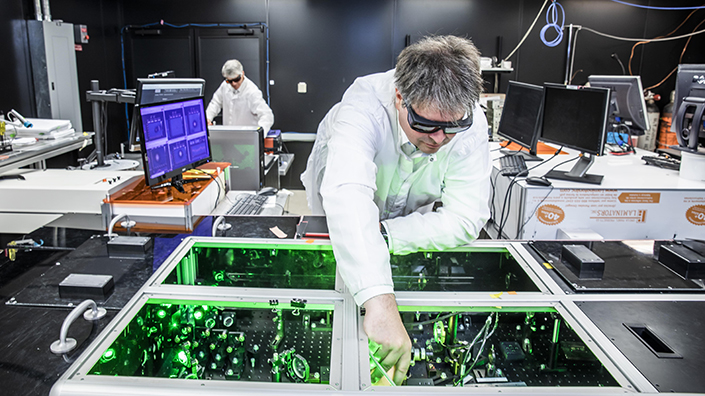TAU Systems calls this mysterious world, which it aims to access with its particle accelerators, the ‘Ultraverse’. The scales involved can be difficult to visualise – the company talks in terms of angstroms (0.1 nanometre) and attoseconds (one quintillionth of a second).
The devices probing these minute fractions of space and time will themselves be on a much smaller scale than conventional particle accelerators. Unlike today’s giant facilities – the Large Hadron Collider, for example, which stretches for 27km beneath the French-Swiss border – TAU’s plasma accelerator will be the size of two shipping containers, the company claims.
By going from “miles to metres and billions of dollars to millions”, the Texan firm aims to democratise access to particle accelerators, ending the domination of countries and governmental organisations over the few available machines and giving ‘beamtime’ to researchers at universities and companies around the world.
Opening up the Ultraverse could have far-reaching consequences in diverse fields, including medicine, nuclear waste treatment and climate change studies – and some others that have likely not been imagined yet.
Catching waves
An unusual analogy is helpful when explaining the complex workings of the company's device, a type of X-Ray Free-Electron Laser (XFEL). The electrons, the particles that will be accelerated in the machines instead of more conventional protons, are surfers. The ‘water’ is a small 10x3cm tube filled with helium gas, which is ionised by ultra-intense lasers to create plasma. The waves are three-dimensional plasma waves, which will accelerate the electrons to ultra-high energies.
“Just like when a boat goes over a lake, it will draw a wake,” says TAU founder Bjorn Manuel Hegelich. “You can actually surf on that wave, and you can just sort of carry yourself along behind the boat on that wave. And that's what happens in this plasma, only it happens in three dimensions, not just two. The laser draws a plasma wave, and the electrons can surf in that plasma wave, follow the laser, and gain energy and get accelerated to [almost] the speed of light.”
That in itself is not unusual for a particle accelerator. The big difference is the “0-60”, Hegelich says – the acceleration happens over a much shorter distance. “We accelerate the electrons over a distance of about 10cm to 10 Giga-electronvolts (GeV), whereas 10GeV with a conventional machine is at a few kilometres,” he says.
“We can do this because we use a laser to drive the accelerator and we use plasma as a medium to accelerate in, whereas a conventional accelerator uses radio frequency and uses a metal structure, copper or niobium or something like that. Any metal, any material has a breaking point. So in a normal accelerator, you can only make the accelerating field so strong, and if you make it stronger, you damage the material.”
Like the giant waves off Hawaii or the Atlantic coast of Portugal, the process will concentrate vast amounts of power in a specific place. Elementary particles will collide and create other particles, or radiation sources such as X-Rays that will allow researchers to observe and control matter on a molecular and atomic level.
Laser breakthrough
Hegelich, a professor at the University of Texas at Austin and an expert in laser plasma interaction, is speaking to Professional Engineering while visiting London. The company emerged from ‘stealth mode’ in September 2022 following a series of breakthroughs in the US, UK, Germany and France.
“Now we feel the technology is ripe, it's at a level where we've demonstrated the basic underlying science,” says Hegelich. “We're now at the level where we can think about commercialising it and transferring from laboratory experiment to an actual machine.”

Bjorn Manuel Hegelich aligns laser beams in the lab
The firm’s own breakthroughs on laser technology are central to its work, including improvements in shot rate and stability, which boosted the energy and number of particles in an accelerator by a factor of five.
“People have developed lasers that have a much higher shot rate,” says Hegelich. “Instead of one shot every hour, or every minute, now we're talking 10 shots per second… The generation we are building now in our lab is going to be 100 shots per second. That allows you to put closed-loop feedback systems on the system, you can measure something and send it back to the front of the system to control something.”
Another vital addition is machine learning, which can handle the handle the countless parameters from such complex systems, controlling and maintaining the multi-dimensional space better than a human operator could.
Proteins, batteries and nuclear waste
Such powerful processes in relatively compact systems could be transformational for researchers around the world. The incredibly bright and short X-Ray pulses generated by the XFEL will reveal individual atoms and molecules, showing how electrons can jump from one to the other.
“You can look at proteins, for example, and determine what three-dimensional shape they have,” says Hegelich. “Up to now we could only do that with a very few selection of proteins… with an XFEL, you can do this for all kinds.” The femtosecond or sub-femtosecond pulses will reveal protein dynamics, he says, showing how they interact with each other.
That is just one example. The company’s business model is two-pronged – it will offer ‘beamtime’, data acquisition and analysis as a full-service supplier, as well as providing complete laser-driven accelerators and XFEL systems for sale. Interested markets could include pharmaceuticals, where scientists might use XFEL insights to create custom medicines, or renewable energy, where engineers could improve solar cells.

An illustration of the three-dimensional plasma wave
Batteries could be another promising area, says Hegelich. Over time, battery capacity falls as they are charged and discharged, but XFELs could provide deeper insight to improve cells for everything from mobile phones to EVs and renewable energy storage.
Charging and discharging a battery in the system, Hegelich says, “you can see on a molecular level what contributes to the decreasing performance, if you charge them fast, or slow, or repeatedly.” Engineers could also experiment with adding graphene layers, for example, to stop damaging dendrites from growing between different parts of the battery. An XFEL system could then assess their performance.
In future, XFEL systems could even ‘eliminate’ nuclear waste, TAU claims, by ‘transmuting’ one element to another. Such a neat process is a long way off, however, with Hegelich describing it as the “most difficult” application.
“The physics is pretty clear, we've done this for many decades,” he says. “You can basically use an accelerator to make neutrons, the neutrons hit your nuclear waste, and just like in a reactor they cause them to transmute from one element to another, and you can drive them from something that has a half-life of 100,000 years to something that has a half-life of 100 years.”
He continues: “The problem is doing it efficiently, right? Because accelerating particles to that energy to allow transmutation to happen requires energy, and if you need more energy to transmute the waste… you have a losing proposition, because why make the waste in the first place if you're not even getting the energy out of it? So you have to find a way that's economically efficient enough that you still have a net energy gain in the whole chain…
“We think we can ultimately do this with lasers, but the engineering challenge is to develop lasers with enough average power, many megawatts.”
From billions to millions
Today, the Ultraverse is closed off to all but a select few scientists working at publicly funded research institutions. Companies could not buy beamtime if they wanted to, Hegelich says, because there are so few particle accelerators in the world and such high demand for their work. “If we can build these machines, and we can get the footprint down to where it can fit into a factory building or a university campus, and the price down to where it's affordable, then many, many more disciplines will have access and actually use this technology.”
As TAU emerged from stealth mode, it had laboratory prototypes at universities, and was starting to build its first industrial prototype. It is building academic and industrial partnerships, including with the Lawrence Berkeley National Laboratory in California, to develop its laser technology and leverage up-to-date scientific advances. It aims to offer its first products for sale in 2024, have an XFEL service centre operational by 2026, and start selling full XFEL systems by 2027.
“The challenge now is to take this thing that we've developed as scientists, and really get engineers to work on it and make it an actual product that is robust, that people who are non-experts can use – I mean, maybe well-trained technicians, but non-PhD scientists,” Hegelich says.
Instead of a few dozen billion dollars, TAU hopes to provide particle accelerators for a few dozen million. Hegelich predicts a similar progression to computer technology – at first, the only ones available were much too big and exclusive for many people to use, but gradually the technology was miniaturised and access became much easier. Giant supercomputers still exist for the most complex work, in the same way that the LHC and other large accelerators will still be needed in a world of XFELs.
“We're not saying, or claiming right now that we're going to match them at every parameter,” Hegelich says. “We don't need to – if we can do 50% of what they can do, or 80%, that will keep so many people busy for so long.”
Want the best engineering stories delivered straight to your inbox? The Professional Engineering newsletter gives you vital updates on the most cutting-edge engineering and exciting new job opportunities. To sign up, click here.
Content published by Professional Engineering does not necessarily represent the views of the Institution of Mechanical Engineers.